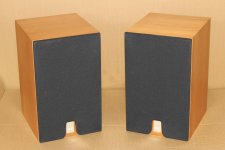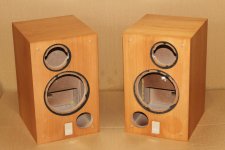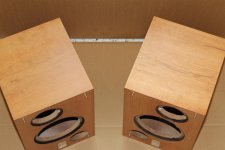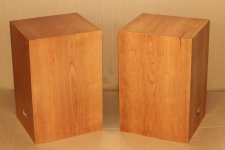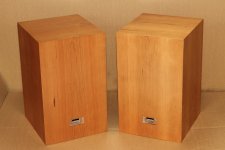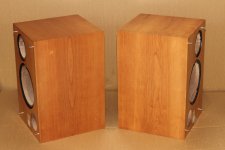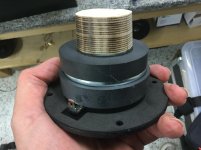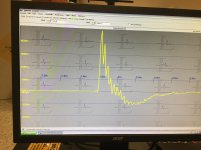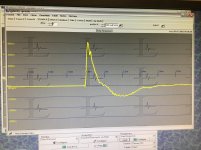The xover remark you have comes from experience working with them. I have no useful information to add here. But I know very few manufacturers these days use ferrofluid. If it was the holy grail at one point, then it isn't anymore. But I do get that a fluid will calm the tweeter. Which in a way is a killing point since metal domes ARE all about a better resolution and extra details which soft domes often can't reproduce.
But in this case, I will say that SEAS 27TDC H1149 does a really good job. To my ears its an excellent tweeter. Which made me interested in the 27TBC/G or 27 TBFC/G hoping for some extra harmonics and lifted high end. I like crisp and detailed tweeters.
But in this case, I will say that SEAS 27TDC H1149 does a really good job. To my ears its an excellent tweeter. Which made me interested in the 27TBC/G or 27 TBFC/G hoping for some extra harmonics and lifted high end. I like crisp and detailed tweeters.
I modify the grill and notch out the ultra sonic resonance. Then they are fine for the price.
The reason today Ferrofluid is not much used any more is that there are better ways to glue now that can stand more temperature.
Ferrofluid teeeters simply did not burn out as much so they had a reliability advantage.
On the other hand Ferrofluid can dry out and block the coil. I have seen that in the past.
There are also new, thinner types of fluid with which you can strike a compromise.
The reason today Ferrofluid is not much used any more is that there are better ways to glue now that can stand more temperature.
Ferrofluid teeeters simply did not burn out as much so they had a reliability advantage.
On the other hand Ferrofluid can dry out and block the coil. I have seen that in the past.
There are also new, thinner types of fluid with which you can strike a compromise.
Since we are talking about the cone breakup which spike at roughly 26-27 kHz. if we look at the graph from SEAS, there is a gradual slope from 12-13 kHz down -13 dB (natural 2nd order), what is the difference between using a notch compared to band stop filter - yes on the whole tweeter. If we look at the peek, the response after that is more or less useless - or perhaps allowing the tweeter to come back (notch) we regain some of the higher harmonics ... ???I modify the grill and notch out the ultra sonic resonance.
I get nothing for being a fan boy of Joachim's speaker, I bought his Suesskind Progress full price, I have the Sonics Anima in walnut and in Zebrano as well as an Arkadia in Black Ash and I just wanted to remind everybody what a great opportunity that is.
Sonics Anima loudspeaker | Stereophile.com
Who is using Sonics Anima Monitors? - Gearslutz Pro Audio Community
My Anima pair is a version with the ER15RLY with the reed cone, I think Joachim mentioned that whene he designed the Anima that driver was not on the market. He can say for himself why he likes it so much, if time permits I will make a thread for the active Audiolense version I am working on with the Zebrano boxes.
Sonics Anima loudspeaker | Stereophile.com
Who is using Sonics Anima Monitors? - Gearslutz Pro Audio Community
My Anima pair is a version with the ER15RLY with the reed cone, I think Joachim mentioned that whene he designed the Anima that driver was not on the market. He can say for himself why he likes it so much, if time permits I will make a thread for the active Audiolense version I am working on with the Zebrano boxes.
I made versions of the Anima with metal cone and also with reed cone in the mid-bass.
All said and done i may like the metal cone version still best. It has the advantage that both drivers have a membrane from similar materials ( although not totally the same ) and the bass is maybe a little bit better defined beacuse the metal cone is more ridgid.
I can make better crossovers then over 10 yeras ago so my new versions are better then the old i think. The Anima i made for Studio use was very successfull and is still in use in many professional mixing and mastering houses.
I have some experience with DSP solutions too. I work with AudioVero ( Dr. Uli Brüggemann ) and there are the new Fusion Plate amps from Hypex i also plan to try.
For the price i offer the Anima here it may be difficult to get something better. It is a great bargain.
All said and done i may like the metal cone version still best. It has the advantage that both drivers have a membrane from similar materials ( although not totally the same ) and the bass is maybe a little bit better defined beacuse the metal cone is more ridgid.
I can make better crossovers then over 10 yeras ago so my new versions are better then the old i think. The Anima i made for Studio use was very successfull and is still in use in many professional mixing and mastering houses.
I have some experience with DSP solutions too. I work with AudioVero ( Dr. Uli Brüggemann ) and there are the new Fusion Plate amps from Hypex i also plan to try.
For the price i offer the Anima here it may be difficult to get something better. It is a great bargain.
Last edited:
Here some more photos of the Oumnia 2.0.
The woofers are Peerless with a stiff and well damped Polypropylene cone.
The tweeters are modified SEAS metal domes.
The sound of that speaker is very open and transparent. The midrange is low in coloration.
The bass is tight, deep and fast. They throw a wonderful soundstage.
are these still available?
I am working on a Last Edition Sonics Arkadia.
Only 5 pairs will be made.
The woofer is a 20cm driver that i designed together with SEAS.
It has a classic paper membrane with a dust cap that is stiffened with reed fibers.
It has an enormous magnet so sensitivity is 92dB/2.85/8Ohm.
The pole piece has a copper cap for low distortion.
A soft rubber surround and a non conducting voicecoil gives low mechanical losses for good low level resolution.
Cone breakup is very benign.
I will post some pictures of that driver soon.
The tweeter is a new Peerless dome with light metal membrane.
Moving mass is low and it has a double magnet so sensitivity is high.
This is needed because the woofers are so loud.
Only 5 pairs will be made.
The woofer is a 20cm driver that i designed together with SEAS.
It has a classic paper membrane with a dust cap that is stiffened with reed fibers.
It has an enormous magnet so sensitivity is 92dB/2.85/8Ohm.
The pole piece has a copper cap for low distortion.
A soft rubber surround and a non conducting voicecoil gives low mechanical losses for good low level resolution.
Cone breakup is very benign.
I will post some pictures of that driver soon.
The tweeter is a new Peerless dome with light metal membrane.
Moving mass is low and it has a double magnet so sensitivity is high.
This is needed because the woofers are so loud.
The parameters of the woofer are optimized for the 40 Liter cabinets of the Arkadia.
I use a siighly overdamped bass reflex tuning with a low 32Hz minimum.
Bass is really tight and deep for this rather small volume.
I modified the tweeter. It has a rather flimsy round paper thingy to close the volume in the back so I added some damping and stiffening in the form of multiplex wood.
The ca. 27kHz come brackup is controlled by a precision trap. This proved rather difficult.
I needed two days to find the optimum compromise.
The improvements show as lower intermodulation distortion and optimized Impuls response.
I use a siighly overdamped bass reflex tuning with a low 32Hz minimum.
Bass is really tight and deep for this rather small volume.
I modified the tweeter. It has a rather flimsy round paper thingy to close the volume in the back so I added some damping and stiffening in the form of multiplex wood.
The ca. 27kHz come brackup is controlled by a precision trap. This proved rather difficult.
I needed two days to find the optimum compromise.
The improvements show as lower intermodulation distortion and optimized Impuls response.
Here are pictures of the modified tweeter and the step response before and after using the trap.
This was recorded with a 96kHz sampling rate and 16Bit.
This was recorded with a 96kHz sampling rate and 16Bit.
Attachments
Last edited:
- Home
- Vendor's Bazaar
- Sonics by Joachim Gerhard cabinets and kits
